Persepolis Fortification Archive Project Annual Report 2009-2010
Part. 1
Matthew W. Stolper / Persepolis Fortification Archive Project
Source : http://www.payvand.com/news/10/dec/1133.html
The Persepolis Fortification Archive is a treasury of information about the languages, society, institutions, religion, and art of the Achaemenid Persian Empire at its zenith, around 500 bc. Its value depends on a combination of complexity (the archive contains detailed information of many different kinds) and integrity (the archive is an excavated artifact, a single, coherent cache of tens of thousands of documents from a single time and place).
The legal crisis that puts the future of the many Persepolis Fortification tablets in doubt also endangers the integrity of the single Persepolis Fortification Archive. The suit is still before federal courts, and the threat remains grave and persistent, but while the law takes its stately course, the Persepolis Fortification Archive Project pursues its emergency priorities: to enable future research by making thorough records of the archive, and to enable current research by distributing the records freely and continuously.

Figure 1. Four BetterLight scans of a fragmentary Persepolis Fortification Aramaic tablet (PFAT 684). Clockwise from upper left:
polarized light, infrared filter, negative tone scale, red filter
During 2009-2010, Clinton Moyer (PhD 2009, Cornell), Joseph Lam (PhD candidate, NELC), Miller Prosser (PhD candidate, NELC), and John Walton (PhD candidate, NELC) continued to operate the two Polynomial Texture Mapping (PTM) domes and the BetterLight scanning camera, making very high-quality images of selected Fortification tablets and fragments (fig. 1). As of mid-2010, this phase of the project - a collaboration with the West Semitic Research Project (WSRP) at the University of Southern California - has captured images of about 2,600 items: more than 670 monolingual Aramaic tablets, more than 200 Aramaic epigraphs on tablets with Elamite cuneiform texts, about 1,500 sealed, uninscribed tablets, and about 200 Elamite tablets and fragments.

Figure 2. Wear and repair on one of the PTM domes
The range of imaging techniques, the range of detail that they reveal, and the rate of output from this phase of the project grow with experience. Making the images outruns processing them for display, so two PTM-image processing stations have been added at the Oriental Institute to supplement post-processing done at the University of Southern California. Despite the duct-tape and baling-wire look of the PTM domes (fig. 2), their reliability is outstanding: the shutters of the cameras on the two PTM domes have tripped more than 1,000,000 times during the life of the project.
Manning the post-processing stations are some of the crew who are also making and editing conventional digital images of the largest component of the Persepolis Fortification Archive, the Elamite Fortification tablets and fragments. During the past year, this group included Lori Calabria, Jon Clindaniel, Gregory Hebda, Will Kent, Megaera Lorenz, Tytus Mikolajczak, and Lise Truex (all NELC), Joshua Skornik (Divinity School); Anastasia Chaplygina (MAPH); Nicholas Geller, Amy Genova, Erika Jeck, and Daniel Whittington (Classics); and returning Persepolis Fortification Archive Project alumnus Trevor Crowell (Catholic University). Three photography and editing stations are in use now, and so far this phase of the project has made about 50,000 images of about 4,000 tablets and fragments with Elamite cuneiform texts. Editing these pictures for display now runs ahead of taking them, so the backlog is shrinking. Older picture sets are being checked and reshot as necessary for completeness and to match the higher standards of the later sets that reflect the photographers' accumulated experience. Haphazard file names from earlier picture sets are being made consistent with later sets, to facilitate linked online display and to prepare metadata for long-term storage.
After two more extended visits to the Oriental Institute, Persepolis Fortification Archive Project editor Wouter Henkelman (Free University of Amsterdam and College de France) has finished revised, collated, and annotated editions of about 2,400 of the 2,600 Elamite texts known from preliminary editions by the late Richard Hallock (called NN texts). He expects to collate the remainder in the summer and autumn of 2010 and to furnish complete translations in preparation for online distribution and hard-copy publication. I have continued to make preliminary editions of new Elamite Fortification texts, concentrating on document types that are underrepresented in the published sample of the Persepolis Fortification Archive; as of mid-2010, I have recorded about 585 of these.
The second largest component of the Persepolis Fortification Archive consists of uninscribed (anepigraphic) tablets (PFUT or PFAnep), that is, tablets with seal impressions but without accompanying texts. Our first estimates of the number of useful pieces of this kind were too low. During nine trips to the Oriental Institute during the past year, Persepolis Fortification Archive Project editor Mark Garrison (Trinity University) systematically examined another 25 percent of the 2,600 boxes of Fortification tablets and fragments to select uninscribed tablets for cataloging and PTM imaging. Now that about half of the boxes of tablets have been sifted, more than 2,100 uninscribed tablets have been selected for study. Post-doctoral researcher Sabrina Maras (University of California-Berkeley) is cataloging this material under Garrison's direction, a process that involves identifying impressions of previously known seals, assigning numbers to new seals, and sketching impressions of them; during the summer of 2010, she is joined in this work by graduate student Jenn Finn (University of Michigan). The results continue to bear out the general observation that some seals used on uninscribed tablets were also used on Elamite or Aramaic Fortification tablets, but most - around ten times as many - were not: on 275 cataloged tablets, there are impressions of more than thirty seals previously known from tablets with Elamite texts, but there are also impressions of 300 new seals. Garrison also continues to read the seals on the NN tablets. As of mid-2010, he has identified seal impressions on almost half of the NN tablets, and about 1,250 tablets that have yielded impressions of another 465 previously unknown seals. Post-doctoral student Wu Xin (Institute for the Study of the Ancient World, New York) is documenting some of this material under Garrison's direction.

Figure 3. Impression of a newly identified inscribed seal in Assyrian style accompanying
a newly edited Elamite text of an underrepresented type
All told, impressions of about 2,500 distinct seals have been cataloged on Persepolis Fortification tablets so far, the markers of as many distinct individuals and offices. Even if new seals are identified at a slower rate as work continues, the Persepolis Fortification Archive is certain to yield one of the largest coherent sets of images from anywhere in the ancient world.
The third main component of the Persepolis Fortification Archive consists of tablets with texts in Aramaic, some 670 identified to date. Persepolis Fortification Archive Project editor Annalisa Azzoni (Vanderbilt University) made two extended trips to the Oriental Institute during the past year to work on them. She has examined, numbered, cataloged, and made preliminary editions of about 100 monolingual Aramaic tablets and about 110 of the 200 Aramaic epigraphs on Elamite tablets identified so far. She is developing a formal typology of the documents to allow consistency with work on the Elamite texts and to clarify functional connections among streams of data recorded in Aramaic and in Elamite. Graduate student Emily Wilson (Classics), working under the direction of Persepolis Fortification Archive Project editors Elspeth Dusinberre (University of Colorado) and Mark Garrison, has been completing Dusinberre's collated drawings of seals on the Aramaic tablets and entering new descriptive and cataloging data on the PFAT seals in the On-Line Cultural Heritage Research Environment (OCHRE).

Figure 4. What the seals show that the texts do not: PTM views of altar scenes from seal impressions on four uninscribed fortification tablets

Figure 5. What the seals tell about the seal users: among 2,500 seals identified so far in the PFA, only four show scenes of human warfare; here, a Persian archer shoots a Scythian warrior in the seal impression on an Elamite Fortification tablet
PART. 2